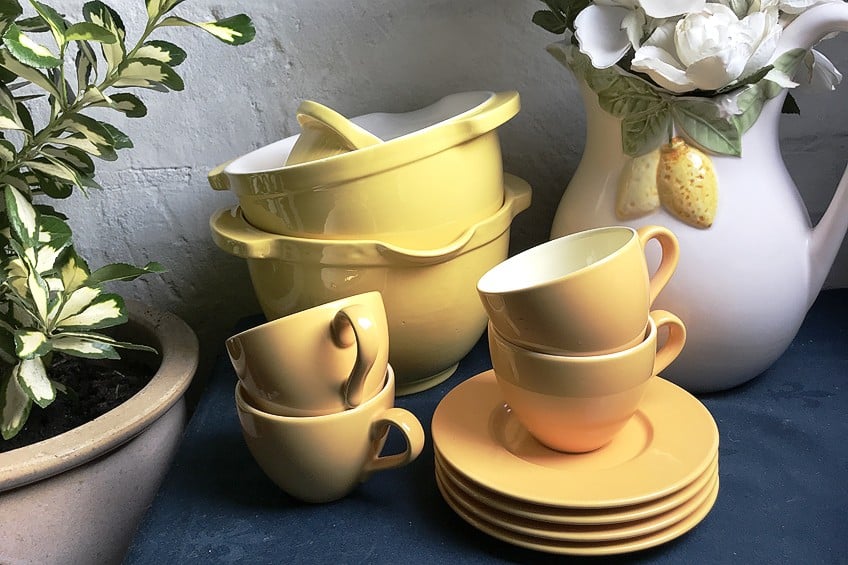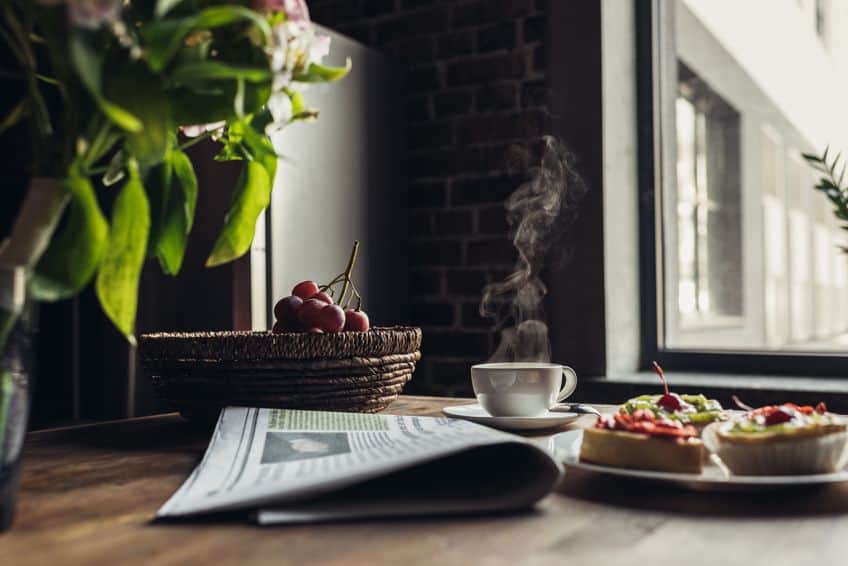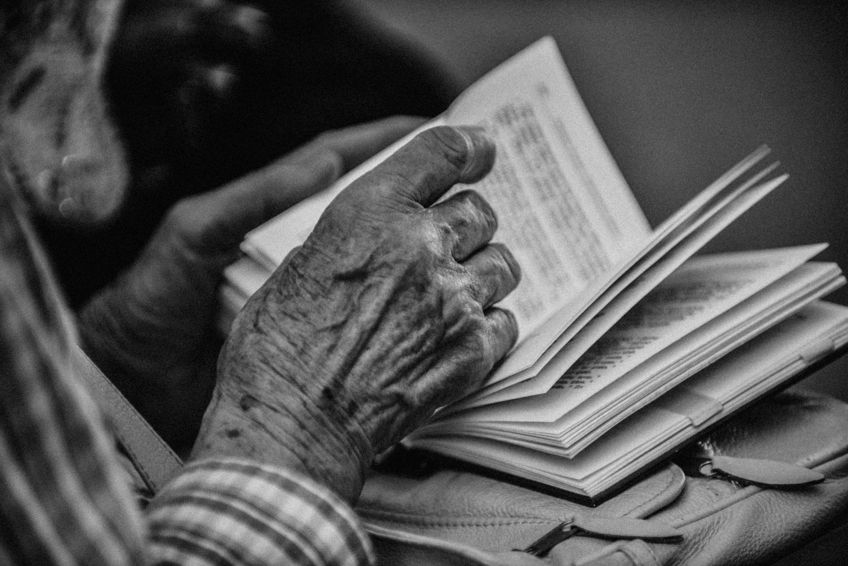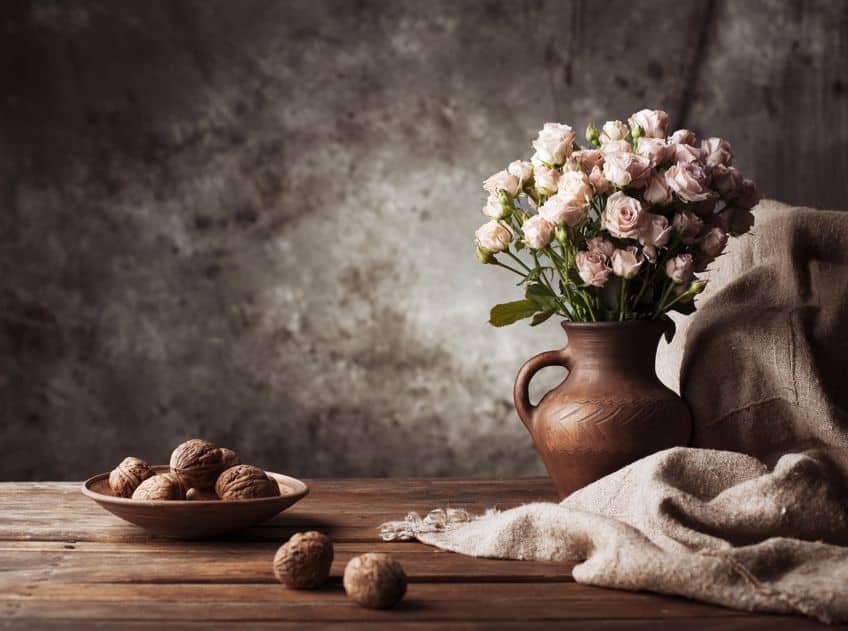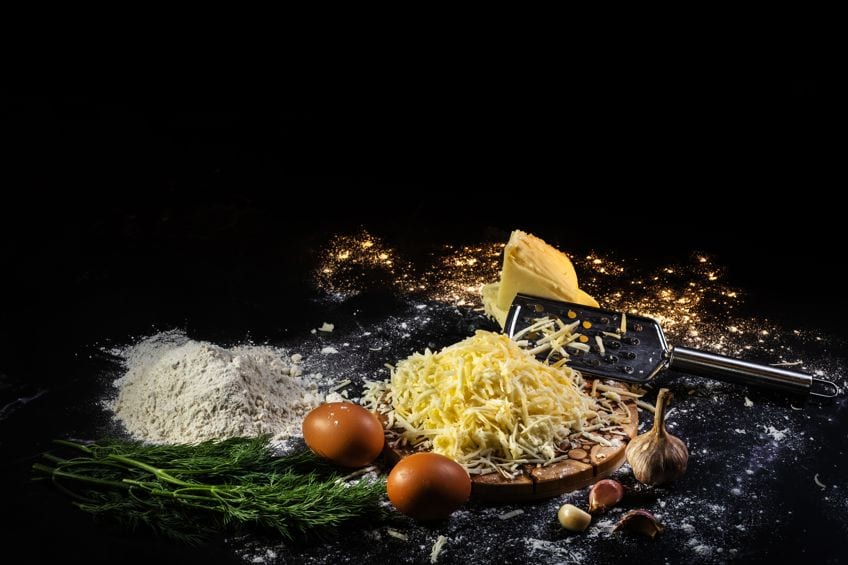What Is Still Life Photography? – Mastering the Inanimate
What is still-life photography, and when did this art form originate? There are many different types of still-life photography that help artists tell different stories using specific sets of visual languages, techniques, and equipment. In this article, we will explore the origins of still-life photography, including the relevant techniques and equipment, the different types of still-life photography, some of the best examples of still-life photography, and a few key tips for aspiring still-life photographers that will give you more than enough information about the art form. Keep reading for more about the incredible world of still-life photography!
Contents
- 1 Curating the Inanimate: Defining Still Life Photography
- 2 Exploring the History of Still-Life Photography
- 3 Crafting Still-Life: Techniques and Equipment
- 4 Exploring the Different Types of Still-Life Photography
- 5 The Art of Storytelling Through Still-Life Photography
- 5.1 Examples of Famous Storytelling Through Still-Life Photography
- 5.1.1 Articles of Vertú (c. 1855) by Thomas Richard Williams
- 5.1.2 George Bernard Shaw’s Work Table (1939) by James Jarché
- 5.1.3 Birthday Gloves, New York (1947) by Horst P. Horst
- 5.1.4 A Dead North Vietnamese Soldier and his Plundered Belongings, Hue (1968) by Don McCullin
- 5.1.5 Urban Still Life (Cold Alley) (2014) by Ben Roffelsen
- 5.1 Examples of Famous Storytelling Through Still-Life Photography
- 6 Tips for Creating Still-Life Photographs
- 7 Frequently Asked Questions
Curating the Inanimate: Defining Still Life Photography
What is still-life in photography? Numerous examples of still-life photography can be found on the internet today and have become a key part of consumerism and advertising that very much govern our lifestyles. Still-life photography is an art form that relies on producing photographic imagery of inanimate objects and is similar to the practice of still-life painting.
Since the emergence of photography as an art form, the role of still-life photography progressed into a multitude of variations, such that the art form is divided into different categories.
Two of the most crucial elements in still-life photography are framing and lighting, which are key to defining a still-life and creating an excellent composition. Popular inanimate objects such as vases, fruits, tables, and vegetables find themselves in centuries-old still-life photographs that relied on the curation of objects.
What Makes Still-Life Photography Unique?
So, what makes the practice of still-life photography so unique? What is so fascinating about photographing inanimate objects and memorabilia? A simple image of a fruit or vase can quickly become a symbol of luxury or the social status of the individual who owns the object. Still-life photography plays an important role in shaping the interpretation of the objects it captures and relays to its viewers, what is worth being photographed and what is not.
When unpacking the question “what is still-life in photography?”, it is useful to understand the genre’s different functions from an art historical perspective.
While a painting of a basket of fruit might be used to promote the artistic and technical painting skills of a Realist artist, a photograph of a basket of fruit alludes to something else. One such element is longevity since the longevity of a photograph is higher than the longevity of a painting, which if not treated properly, will fade, weather, and perhaps lose its initial visual impact. With modern technologies and photographic tools, the preservation of images is easier and is also highly adaptable to their function. Still-life photography can be used in almost any sector to promote the object or the eye of the photographer.
Still-life photography can also capture, in a split second, the reality of objects as they appear to the photographer and with the help of photographic equipment and minor editing, present objects in spaces that help viewers critique the role of inanimate objects. The significance of still-life photography is thus undoubtedly immense given its versatility and role in fine art photography. Still-life photography can infiltrate the fields of advertising and marketing through product photography as a form of still-life, however, that same product image can also be used in fine art photography as part of an artist’s conceptual body of work.
The power of still-life photography thus lies in the power of the image, the object, and the circulation of images in and out of the fine art sphere.
Exploring the History of Still-Life Photography
The history of still-life photography is interlinked with the history of photography itself since the earliest forms of photography were tested via still-life and portraiture. Below, we will unpack the origins of still-life photography and its progression as a fine art practice from still-life painting to the early pioneers of still-life photography.

The Importance of Still-Life Painting
The origins of still-life photography find themselves with the emergence of still-life painting, defined by the arrangement of inanimate objects such as flowers, vases, luscious fruits, and intriguing art objects. The term “still-life” was derived from the 17th-century Dutch word stilleven, which attracted the interest of many European painters whose complex compositions and increasingly detailed and realistic still-life paintings became popular. The genre of still-life emerged independently alongside other genres such as portraiture and became a must-have for any household.
The most famous still-life paintings served allegorical meanings and were considered the best form of art to convey hidden messages.
The arrangement of objects became much more complex than the mere representation of an object since the viewer had to consider what objects were shown, where these objects came from, and what these objects alluded to. Still-life painting thus reflected the lifestyle and preferences of a society at its present moment and with the inclusion of imported or luxurious goods and objects, one could assume the social status of the individual.
The Emergence of Still-Life Photography
Still-life painting was incredibly significant to the way that photographers began thinking about representation and composition in still-life photography. While the selection of inanimate objects of the Contemporary era may have shifted, the conventions and approaches are somewhat similar to those of still-life painting. Still-life photography took flight during the development of photographic types such as the daguerreotype, which was championed by Jacques-Louis-Mandé Daguerre as well as other inventors such as William Henry Fox Talbot who played with early forms of still-life photography during experiments. These early still-life images were created for practical purposes, which were imperative to the development of photography.
In the early 19th century, Baron Armand-Pierre Séguier compiled a photograph made up of a selection of sculptures from the Uffizi Gallery and Louvre Museum collections and can thus be considered one of the earliest intentional still-life photographs. The mid-19th century saw the photographer Charles Hippolyte Aubry pursue still-life photography in light of his passions for industrial design and the applied arts. During this period, Aubry also started a new manufacturing company that produced plaster casts and included the photography of flora and fauna.
Early Pioneers of Still-Life Photography
Aside from Jacques-Louis-Mandé Daguerre who helped introduce one of the earliest methods of photography, popular still-life photographers included figures such as Baron Adolf de Meyer, Adolphe Braun, Ansel Adams, Edward Weston, Matthew Brady, and Tina Modotti. Throughout the 16th and 17th centuries, still-life painting was initially referred to as vanitas paintings, which remarked on the fleeting nature of life and its futility despite the pursuit of “pleasure”, indicated by objects of desire. Over time, the vanitas genre of still-life evolved and found its way into still-life photography, given the ease of the new medium and the different photographic methods.
Below, we will introduce you to a selection of the most impactful pioneers of early still-life photography for a closer look at the art of still-life.
Louis-Jacques-Mandé Daguerre (1787 – 1851)
| Artist Name | Louis-Jacques-Mandé Daguerre |
| Date of Birth | 18 November 1787 |
| Date of Death | 10 July 1851 |
| Nationality | French |
| Associated Movements, Themes, and Styles | Still-life photography, landscape art, portraiture, classical symbolism, and Romantic art |
| Mediums | Photography (daguerreotype), painting, and printmaking |
| Famous Artwork | ● Still Life with Plaster Casts (1837) |
Louis-Jacques-Mandé Daguerre was the inventor of the daguerreotype method as well as a Romantic painter and printmaker who produced one of the earliest still-life images to date. His most famous work, Still Life with Plaster Casts (1837), predated the announcement of the daguerreotype as the official photographic medium by two years and remains an iconic artwork of 19th-century still-life photography.
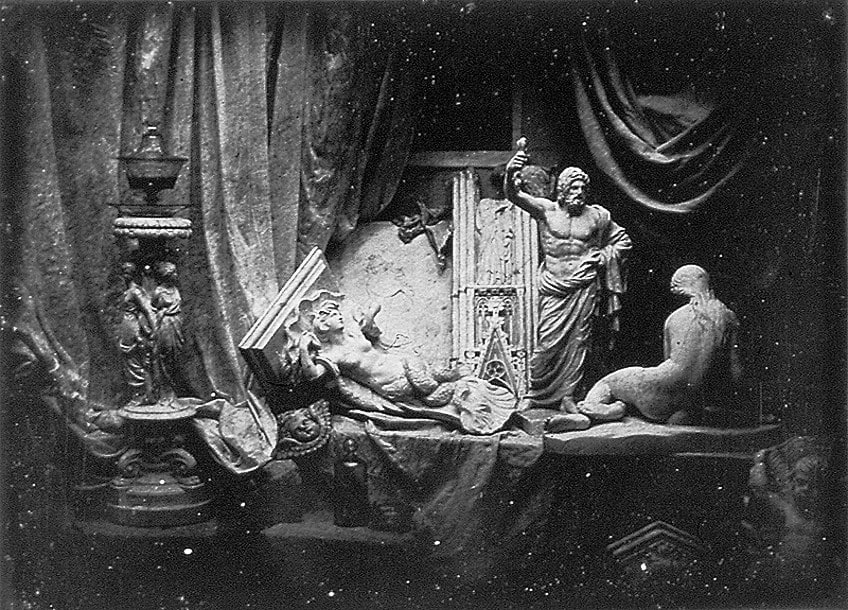
In the photograph, Daguerre frames the composition using curtain drapery and a combination of sculptures and objects at the fore, which were exposed for up to 20 minutes. It was only towards the 20th century that such still-life photographs were accepted for exhibition in fine art environments. A total of only 25 images made by Daguerre survive today and are a testament to the artist’s dedication to the fields of art and science. His early still-life image also provided the foundation for connecting photography as a fine art since its reference can be made to still-life painting.
William Henry Fox Talbot (1800 – 1877)
| Artist Name | William Henry Fox Talbot |
| Date of Birth | 11 February 1800 |
| Date of Death | 17 September 1877 |
| Nationality | British-French |
| Associated Movements, Themes, and Styles | 19th-century photography, salted paper, and calotype |
| Mediums | Photography and drawing |
| Famous Artwork | ● Articles of Glass (1841 – 1844) ● A Scene in a Library (1841 – 1844) ● Articles of China (1843 – 1844) ● The Open Door (1844) ● A Fruit Piece (1846) |
English scientist and still-life photography pioneer William Henry Fox Talbot was among the most famous still-life photographers of the 19th century who contributed vastly to the development of two photographic processes: the salted paper and calotype processes. An innovative man, the British artist was an explorer of all things science, religion, botany, and astronomy, and as such, produced many iconic images through his own techniques. By 1831, Talbot was elected into the Royal Society and was recognized widely for his contributions to integral calculus, chemistry, optics, etymology, and electricity among the many great pursuits and accolades.

It is unquestionably the mastermind of Talbot whose early explorations of still-life began through direct compositions of objects that progressed into complex landscape arrangements. An avid learner of all things history and fundamental to human existence, Talbot also dedicated himself to archaeology and the study of Mesopotamian cultures. Some of his simple yet best compositions include Articles of China (1843 – 1844) and The Open Door (1844), which show off his curatorial eye for structure and objects in man-made environments.
Adolphe Braun (1812 – 1877)
| Artist Name | Jean Adolphe Braun |
| Date of Birth | 13 June 1812 |
| Date of Death | 31 December 1877 |
| Nationality | French |
| Associated Movements, Themes, and Styles | Floral still-life, landscapes, and street photography |
| Mediums | Photography |
| Famous Artwork | ● Flower Study, Rose of Sharon (c. 1854) ● Grapes (1860) ● Still Life of Game (1865) ● Still Life of a Hunting Scene (1867) ● Still Life: Dead Game (1880) |
19th-century French still-life photographer Adolphe Braun was among the early pioneers of still-life photography whose imaginative compositions of ordinary objects, fruit, and flowers as well as hunting tools have become symbols of early still-life. Braun’s early career was rooted in floral design for textiles and through the photography of flowers for inspiration, he discovered his passion for floral still-life photography. Together with the collodion technique, Braun published around 300 still-life photographs in 1855 in an album called Fleurs Photographiées, which immediately grabbed the attention of Parisian art lovers.

Within the same year, he exhibited a new collection of works at the Paris Universal Exposition and two years later, established his own photography company called Braun et Cie. In the mid-1860s, he experimented with another method called the carbon print technique developed by Joseph Wilson Swan to produce a series of still-lifes inspired by hunting scenes and the sculptures from the Louvre and other major art institutions across Italy and France. According to art historians, Braun also helped shape the broader understanding of art history for students in the United States since his photographs were so widely produced and circulated.
Mathew Brady (1822 – 1896)
| Artist Name | Mathew B. Brady |
| Date of Birth | 1822 |
| Date of Death | 15 January 1896 |
| Nationality | American |
| Associated Movements, Themes, and Styles | Civil war, photojournalism, war photography, and still-life photography |
| Mediums | Photography (daguerreotypes) |
| Famous Artwork | ● Several Dead Confederate Artillery Men Lie Outside Dunker Church After The Battle Of Antietam (1861 – 1862) ● Confederate dead behind a stone wall at Fredericksburg, VA (n.d.) |
Although not recognized primarily as a still-life photographer, the war-time photographer Mathew Brady was among the best-known photographers of the American Civil War. Brady’s still-life images also include images of dead soldiers strewn on the ground and photographed to capture the morbid atmosphere in the wake of war.

His images of the war showcase the preparation efforts as well as the effects of the war as seen in his images of soldiers in hospitals, however, battle scenes have evaded the photographer. His early photography of dead soldiers also highlighted the role of the inanimate “human” outside of post-mortem photography as a form of still life, which is a rather morbid and dark act of immortalizing the dead while capturing history.
Crafting Still-Life: Techniques and Equipment
As in any photographic practice, one needs to pay attention to specific techniques and photographic equipment that help make an artwork stand out in the best way possible. Below, we will dive into some of the best techniques and equipment available for you to craft the best still-life images.
Lighting
In photography, lighting is everything, and in still-life, lighting can determine the mood of your image. Lighting equipment such as light reflectors makes for interesting and affordable tools to help manipulate your set’s natural light. When positioned properly, light reflectors can enhance or soften the lighting around a subject. Light reflectors are also available in a variety of colors that range from silver and gold to black.
You can also DIY your own light reflectors by gluing tin foil to cardboard or mounting board for a cheaper alternative. If you are not looking for natural lighting, investing in an off-camera light such as a speed light or strobe light will be beneficial to your shoot. Having a powerful light source that can be moved around freely is essential for creating professional images. Softboxes are also useful tools for shooting compositions where you do not want harsh contrasts. Soft boxes also reduce the spill light and diffuse light from strobe lights or flashes to create even lighting.
Composition
There are many techniques that still-life photographers can use to enhance the composition of an image. These include adopting the rule of thirds where the composition is divided into thirds both vertically and horizontally, and the objects are positioned along the lines of intersection or divisions. For added interest to guide a viewer’s eye, the photographer can use leading lines by leveraging the edges of the objects or background lines to highlight the objects.
Strong compositions can also be made using a shallow depth of field, which blurs the background and places the objects in sharp focus.
Color theory and contrast can be used to build tension or create a sense of harmony using contrasting tones and complementary colors. Balance can be created by focusing on the object’s asymmetry or symmetry in relation to the space they are placed in. Negative spaces can also provide more breathing room for the objects and together with side lighting or backlighting, can influence the mood of the composition.
Backgrounds
Artists can employ a variety of techniques and approaches to creating unique backgrounds. These include the use of premade backdrops for simple compositions that emphasize the object and backdrops with different textures such as vinyl or fabric to add to the concept of the shoot. Textured surfaces such as wood, stone, and metal provide interesting visual effects and backgrounds that help the image feel tactile. Studio lighting is another way that still-life photographers can achieve a natural background or create images where the background complements the object. Studio-produced still-lifes are much more controlled. Lastly, still-life photographers can also use digital editing software to manipulate the backgrounds of images and adjust the texture, lighting, and color for dramatic and stylized aesthetics.
Cameras and Lenses
One does not require a fancy camera to shoot still-life images. Cropped sensor cameras are considered ideal for shooting still-life since compositions in still-life are generally not shot on wide. Cropped sensor cameras are thus perfect for any still-life novice since it is also affordable. Full-frame sensor cameras are also considered a treat; however, they are not necessary in most cases.
A few top recommendations for lenses include macro and close-up lenses that aid in producing creative still-lifes and offer low minimum-focus distances to narrow in on your objects.
Telephoto lenses are also preferred in still-life photography and offer a narrow-angled view that assists in properly filling the frame. Telephoto lenses also offer a shallow depth of field, which is great for focusing on a specific object.
Props
When incorporating props into the shoot, one can ensure the use of props that are relevant to the theme of the still-life and play with different textures such as smooth surfaces and rough fabrics. By ensuring the use of cohesive colors across the props, you can also make sure that the composition is balanced. The scale and proportion of props are also essential to the composition and theme.
Exploring the Different Types of Still-Life Photography
There are two main types of still-life photography and these include found still-life photography and created or constructed still-life photography. Found still-life photography is composed of objects shot from an environment that appears preset to the artist and is captured without the photographer’s intervention.
Here, the composition is based on the photographer’s eye for finding still lives in everyday life.
Created still-life photography is intentional and arranged, which means that the photographer plays an active role in arranging the objects of the composition and can encompass a range of different types of created still-lifes. Below, we will outline a few types of created still-life photography that involve direct participation in the construction of the composition.
Food Photography
Think appealing, fresh, aesthetic, and eat-with-your-eyes. This type of still-life photography is meant to advertise and promote a food product or item in a visually pleasing way and is often used in marketing, advertising, and projects aimed at cookbook photos. Food photography is an art form in itself that presents the viewer with all the appetizing qualities of the ingredient, such that the viewer is tempted to buy it.
Floral Still-Life
Floral still-lifes are images or arrangements that only contain flora and fauna elements. The focus of floral still-life photography is on the physical quality of the flowers, and their colors, and less so on the context or environment it is in.
Floral still-lifes are often portrayed as bouquets in vases, close-ups of flower petals, or a diverse arrangement of flowers against a neutral background.
Tabletop Photography
Tabletop photography is a genre of still-life photography that is characterized by the arrangement of items or objects on a table. The objects are placed in a scattered or standing manner and photographed against a neutral background. Lighting techniques are also employed to highlight the objects and provide a homely or domestic atmosphere. Tabletop photography is also used in product shoots to promote comfort or household products that are familiar.
Product Photography
Product photography focuses on advertising a product and is similar to commercial food photography, yet the difference lies in that product photography tends to focus on providing a clear image of the product as opposed to the minute details.
In product photography, the aim is to give the viewer a full picture of the product with as little distraction as possible.
Found Object Photography
Found object photography is a genre of still life photography that involves the use of found objects and placement of found objects out of their context. In this type of still-life photography, the artist can modify the object and its environment. Artists can also arrange found objects in surreal manners to truly express a concept using found object photography.
The Art of Storytelling Through Still-Life Photography
Photography as a medium is useful in crafting narratives and relies on visual imagery as a language and tool for providing viewers with curated stories. Still-life photography also holds the power to tell a story by relying on the objects, lighting, and composition of the photograph. Light plays a key role in establishing the atmosphere and mood of an image and so does composition, which helps guide the viewer’s eye through the objects.
The selection of objects and clarity of the image can also provide valuable visual information to help build a narrative around a still life.
Examples of Famous Storytelling Through Still-Life Photography
Below, we will review a few examples of still-life photography that will help you visualize the different ways that artists have strategically used objects to create compelling stories. Later, we will also explore a few key still-life photography ideas to enhance your still-life production process.
Articles of Vertú (c. 1855) by Thomas Richard Williams
| Date | c. 1855 |
| Medium | Stereographic daguerreotype |
| Dimensions (cm) | 17.3 x 8.4 |
| Where It Is Housed | Private collection |
Articles of Vertú is one of the most famous examples of still-life that displays a form of storytelling via themes such as destiny and mortality. The famous stereographic daguerreotype was created by the British photographer Thomas Richard Williams and showcases an ornate arrangement of objects that allude to the pleasures of human life.
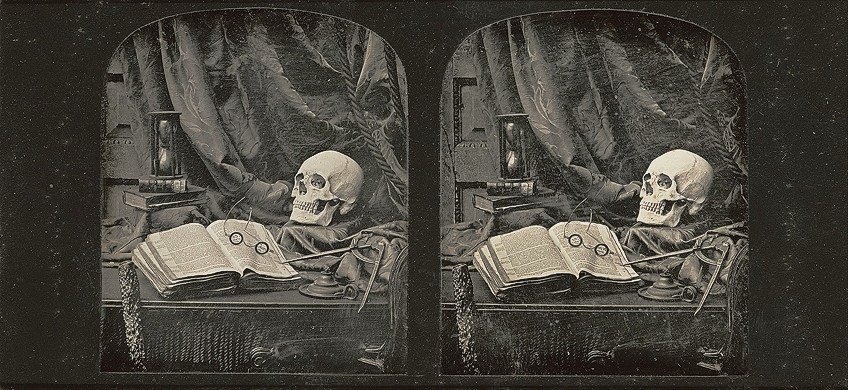
Objects such as the candle holder, a stringed instrument, flowers, sculptures, rich drapery, and cherub figures all convey a sense of opulence and wealth of 19th-century European culture and are reminiscent of vanitas still-life paintings. Mortality is illustrated by the low-burning candle while the composition is entirely well-executed for viewing in three dimensions with a stereoscopic viewer.
George Bernard Shaw’s Work Table (1939) by James Jarché
| Date | 1939 |
| Medium | Silver gelatin print |
| Dimensions (cm) | 15.2 x 12.8 |
| Where It Is Housed | Daily Herald Archive |
A pair of glasses is placed on top of George Bernard Shaw’s notes and was photographed by the Fleet Street photographer James Jarché for Illustrated magazine in 1939. The photograph’s composition also gives the viewer a glimpse into the research-driven playwright by including the many piles of paper in the study that allude to Shaw’s feverish work ethic.

The photograph is an example of how a still life can allude to the character of the object’s owner or the presence of a human figure at work without representing the human figure directly. Still-life photographs thus have the power to display both the presence and absence of the human subject by focusing on the objects that give clues to the character or role of the subject.
Birthday Gloves, New York (1947) by Horst P. Horst
| Date | 1947 |
| Medium | Platinum-palladium print |
| Dimensions (cm) | 46 x 38.4 |
| Where It Is Housed | Private collection |
Birthday Gloves, New York by Horst P. Horst is one of the most famous still-life photos of elitism that was skillfully curated and composed to reflect the dramatic and opulent nature of the white gloves. The focus of the image is on the elegant pose of the figure’s hands as she models the gloves while holding an apple. The use of dramatic contrast in the photo seen in the strong shadows also adds to the composition’s seductive quality. Still-life’s such as Birthday Gloves, New York sell elitism by appealing to the elegance and gentleness of hands wrapped in gloves in an open and poised position.
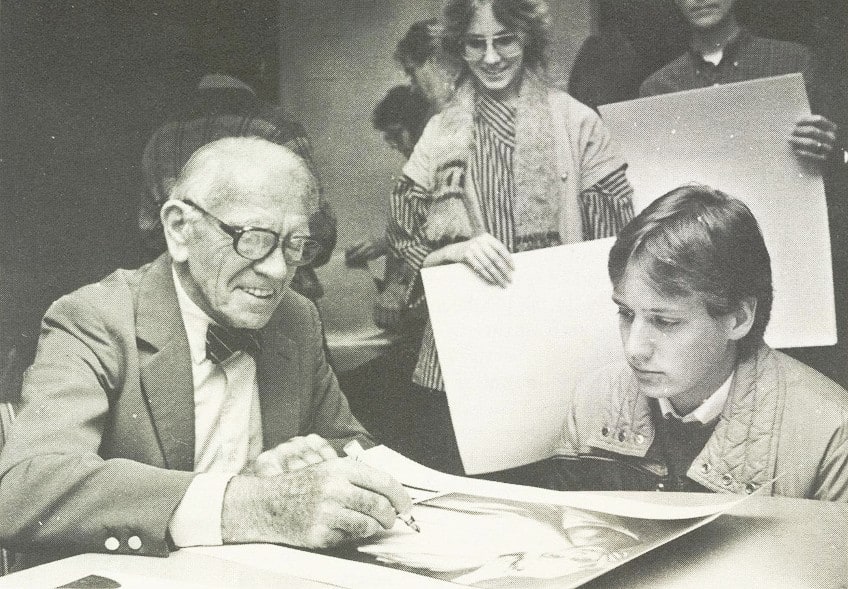
A Dead North Vietnamese Soldier and his Plundered Belongings, Hue (1968) by Don McCullin
| Date | 1968 |
| Medium | Photograph |
| Dimensions (cm) | 28 × 42 |
| Where It Is Housed | Tate Gallery, London, United Kingdom |
A Dead North Vietnamese Soldier and his Plundered Belongings, Hue is among the most chilling still-life photographs to date that were shot as a part documentary, part-staged photograph. The image was shot by Don McCullin in 1968 to highlight nature morte amid warfare and its effects on life. The photograph contains the figure of a dead soldier whose belongings were intentionally arranged around his body for added emotional effect.

The grim black and white photograph also shows a box of photographs strewn on the ground, a bag of bullets, and the soldier’s lifeless hands, all of which gave a direct meaning to “still-life” photography and documentary photography. The narrative of the soldier’s life and the people he left behind for war was crafted by McCullin through the soldier’s personal belongings, which cast against the bullets, make for a powerful and direct photo.
Urban Still Life (Cold Alley) (2014) by Ben Roffelsen
| Date | 2014 |
| Medium | Photograph |
| Dimensions (cm) | Unavailable |
| Where It Is Housed | Artist’s Flickr portfolio |
Urban Still Life (Cold Alley) brings the viewer’s attention to Contemporary and urban still-life photography, which uses color, saturation, and arrangement of found objects in-situ to narrate the cold and unapologetic nature of the urban environment in winter. The lack of warmth in the image is amplified by the artist’s focus on the color blue, which may have been re-colored against the monochrome and neutral building wall.
The scattered objects include a bicycle, a crate, a blue waste bin, and other red-colored elements strewn about the edge of the building.
The presence of snow with the cool and subdued tones also conveys the dull and unforgiving atmosphere. The still-life was shot by urban photographer Ben Roffelsen who skillfully used the door and the air conditioning unit on the far right to frame the composition. The many geometric elements and lines also help convey the inflexible nature of the urban landscape and the “visual temperature” of the photograph.
Tips for Creating Still-Life Photographs
Now that you have witnessed still-life photography in action and how it can be used to convey certain narratives, you will surely benefit from these helpful tips as suggested by professionals, on how to create a good still-life image. These tips are sure to help you generate some innovative still-life photography ideas that will make your work stand out!
Finding Inspiration
If you are at a loss for artistic inspiration, it may be useful to browse through the works of some of your favorite still-life photographers on Pinterest or Instagram to get an idea of different approaches or techniques that you can use to spruce up your shoot. Start with the objects closest to you and brainstorm ways in which you can narrate your own character or the character that you invent in your imagination.
You may also play with different textures when selecting objects to use in your composition and explore the ways that they interact with each other.
One can also experiment with different themes defined by color schemes, time periods, or cultural elements that help set the tone for the composition. Many great still-life images also play with the scale of objects to one another for interesting visual effects. Natural light may be the best and most accessible form of lighting to craft your first few still-lifes so windows may also become your best friend.
Creating a Concept
When crafting a concept, it is easier to settle on a theme that is simple and achievable to avoid overthinking the project. Once you have settled on a theme and color scheme, you can start researching the different techniques and approaches to lighting that you can use to convey a particular mood. By reviewing social media platforms, artist books, and magazines, you can also get an idea of the kinds of props and angles that are used to convey complex themes like elegance, luxury, warmth, or horror. Start with a simple concept and work your way through a checkbox of elements that you need. This can include a set number of props, sources of light, color scheme, and perspective.
Attention to Detail
Some of the best still-life photographs may be simple, yet their effectiveness comes from the amount of detail paid to the smallest elements. Lighting is one such element that requires a detail-oriented approach since it is responsible for shaping the overall mood of the still life. You can choose between natural or artificial light sources to create dramatic, moody, clear, or soft atmospheres. Your background is also key to shaping the way your objects are viewed and needs to complement the objects such that their relationship to each other is evident. Smaller details such as patterns, texture, and an emphasis on certain colors can influence the composition.
By using a tripod, you can also ensure that you maintain the precision and stability of the composition so that you can make any small changes without spending more time and effort restarting the shoot.
Experimentation
Finally, experimenting with still-life photography is highly recommended for creating impactful still-life photographs. You can experiment with different forms of artificial lighting such as strobing to create unique lighting effects. One can also focus on reflections and shadows to help build a sense of depth to the composition while also incorporating reflective materials like glass or mirrors to produce interesting visuals. Experimenting with perspective and angles is also key to creating effective compositions. One can try shooting an image from below for an interesting view of the objects. The post-processing phase is also crucial in defining the final image since you can use software like Lightroom and Photoshop to enhance or highlight specific colors and adjust the lighting, sharpness, and contrast.
There are many types of still-life to explore that will lead you to different visual outcomes that can be strategically incorporated into your art practice. The art of still-life is an age-old art practice that has evolved and adapted to modern technologies, which provides new tools and resources through which innovative artworks can emerge.
Frequently Asked Questions
What Is Still-Life Photography?
Still-life photography is a type of photography that relies on the photography of inanimate objects that are arranged in visually pleasing ways. Still-life photography aims to capture the beauty of everyday objects and narrate stories about them using different photography techniques. Visual elements such as lighting, composition, framing, textures, and color inform the effectiveness of still-life photographs and can include objects such as flowers, vases, fruits, books, and other common objects. Still-life photography emerged from still-life painting, which was popular throughout the 16th and 17th centuries in Europe.
Who Were the Early Pioneers of Still-Life Photography?
Famous 19t-century photographers such as William Henry Fox Talbot, Charles Aubry, Louis-Jacques-Mandé Daguerre, Adolphe Braun, and Mathew Brady, are among the early pioneers of still-life photography.
Who Are the Leading Contemporary Still-Life Photographers?
Popular photographers such as Jonathan Knowles, Jenny Van Sommers, Shihya Kowatari, Laura Letinsky, Sara Tasker, Yukiko Masuda, and Paulette Tavormina, are among the leading Contemporary still-life photographers of the 21st century.
What Are the Different Types of Still-Life Photography?
Product photography, food photography, found-object still-life photography, floral still-life, and tabletop still-life are among the different types of still-life photography practiced today.
Jordan Anthony is a Cape Town-based film photographer, curator, and arts writer. She holds a Bachelor of Art in Fine Arts from the University of the Witwatersrand, Johannesburg, where she explored themes like healing, identity, dreams, and intuitive creation in her Contemporary art practice. Jordan has collaborated with various local art institutions, including the KZNSA Gallery in Durban, the Turbine Art Fair, and the Wits Art Museum. Her photography focuses on abstract color manipulations, portraiture, candid shots, and urban landscapes. She’s intrigued by philosophy, memory, and esotericism, drawing inspiration from Surrealism, Fluxus, and ancient civilizations, as well as childhood influences and found objects. Jordan is working for artfilemagazine since 2022 and writes blog posts about art history and photography.
Learn more about Jordan Anthony and about us.
Cite this Article
Jordan, Anthony, “What Is Still Life Photography? – Mastering the Inanimate.” artfilemagazine – Your Online Art Source. October 5, 2023. URL: https://artfilemagazine.com/what-is-still-life-photography/
Anthony, J. (2023, 5 October). What Is Still Life Photography? – Mastering the Inanimate. artfilemagazine – Your Online Art Source. https://artfilemagazine.com/what-is-still-life-photography/
Anthony, Jordan. “What Is Still Life Photography? – Mastering the Inanimate.” artfilemagazine – Your Online Art Source, October 5, 2023. https://artfilemagazine.com/what-is-still-life-photography/.


